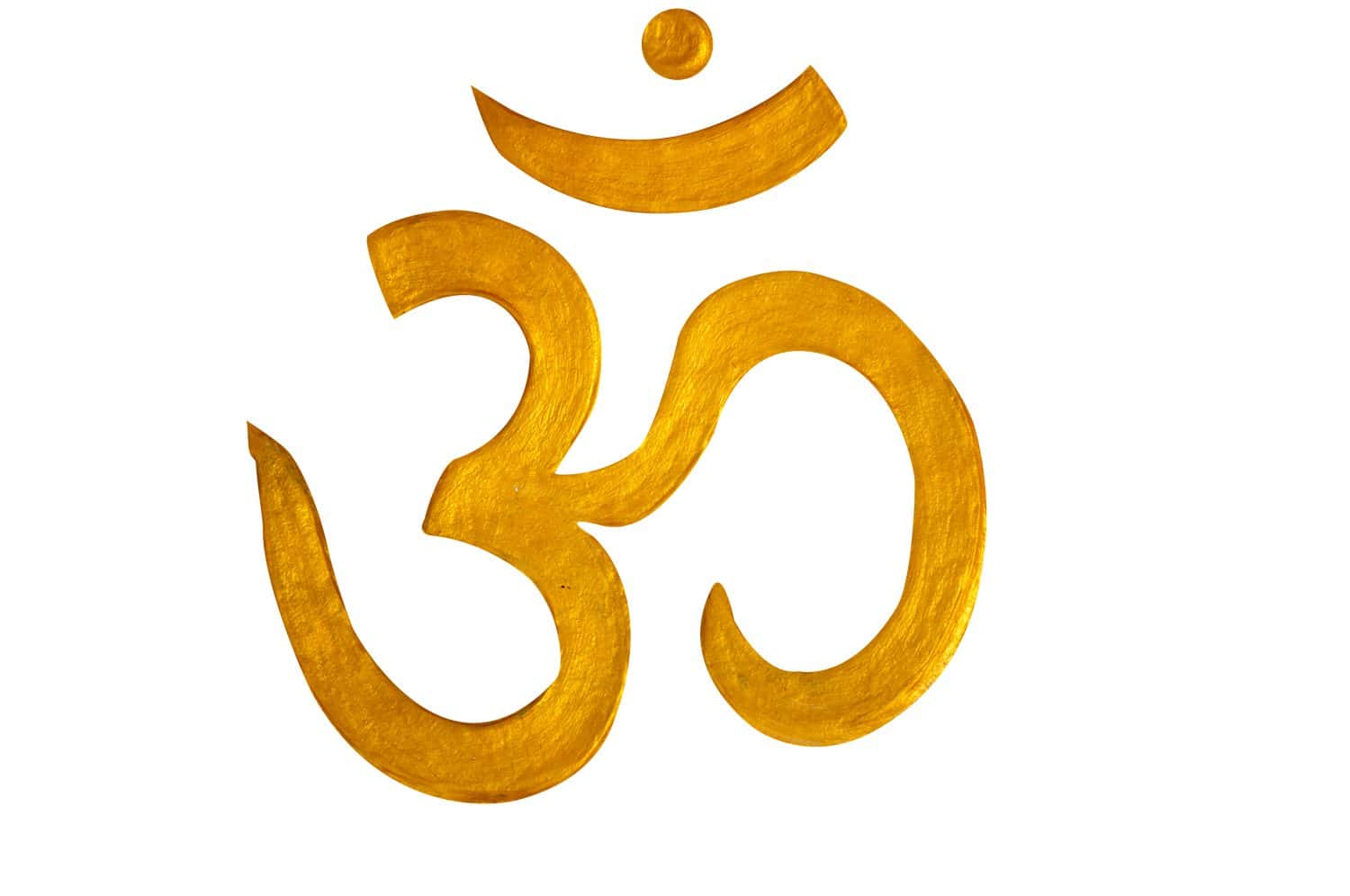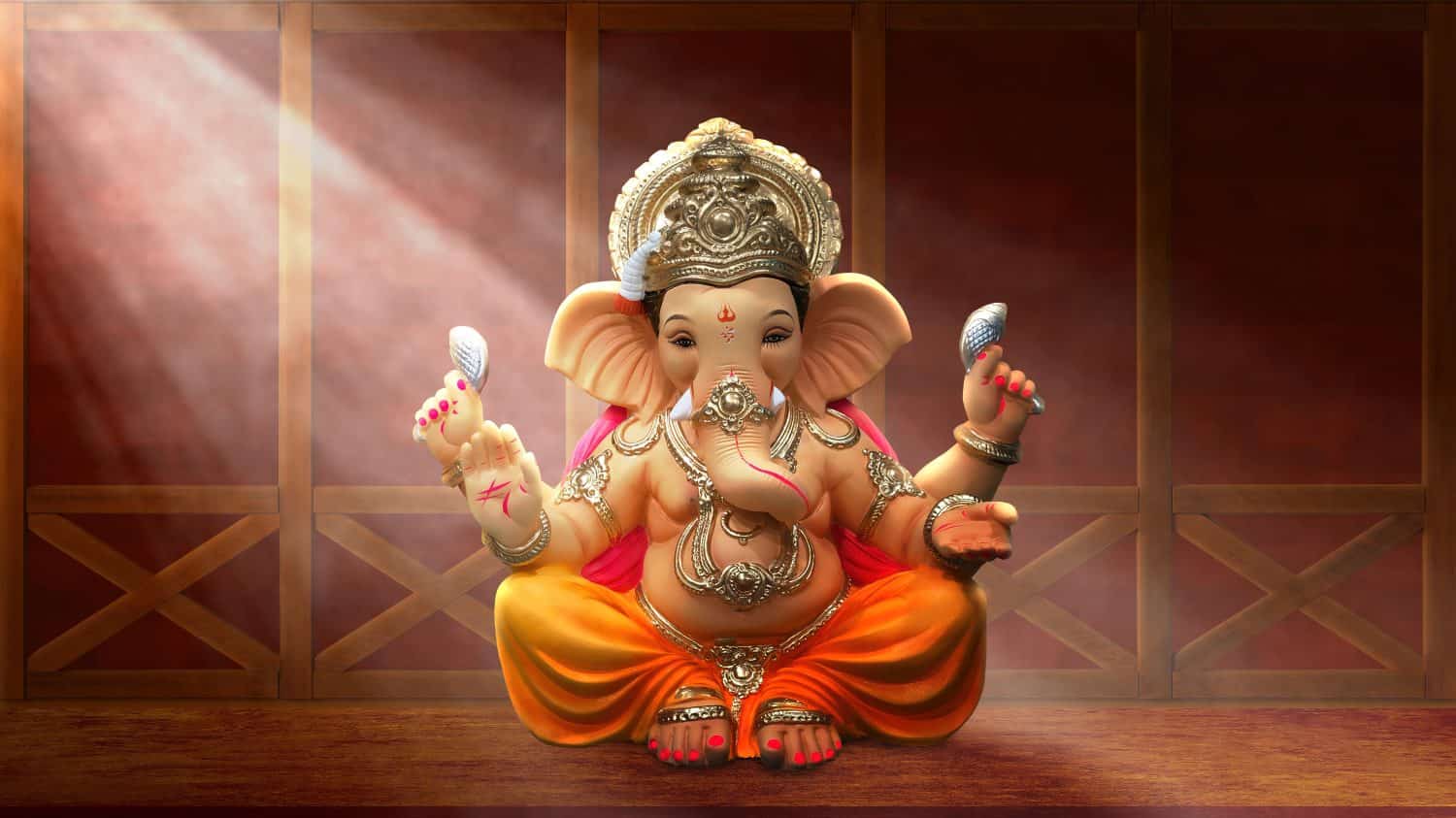Om: the best-known mantra in the world. Try and find anyone who hasn’t heard of it, and it may very well turn out to be impossible. However, not many will be able to tell you what it means — and that’s not surprising. This seemingly simple, one-syllable word has a deep, layered meaning and several possible interpretations.
Still, if you’re starting to practice yoga or meditation, knowing what Om means can be beneficial for your journey. It can help you infuse your practice with more meaning, too. It can also help you relax and, potentially, help you experience a happy, conscious state of mind.
So, let’s start by exploring how to chant Om correctly in the first place. This is important because each sound in this mantra has its own meaning. These partial meanings, of course, impact the meaning of “Om” as a whole.
How Do You Chant Om Correctly?

You can make the Om chant more powerful by combining it with the Om mudra. Mudra refers to a particular hand position in yoga. In this case, the tips of the index finger and the thumb are brought together.
©Roman Samborskyi/Shutterstock.com
Most beginners in yoga and meditation pronounce “Om” exactly as it is written: O-M. However, this is not the most accurate pronunciation. Om is a Sanskrit word, so we should pronounce it according to the rules of this ancient Indian language.
In Sanskrit, o is a diphthong consisting of vowels “a” and “u.” So, we should pronounce the whole mantra as “A-U-M.” Sounds “a” and “u” result in the sound “o,” but we should still pronounce them separately. This is so because each of these sounds has, according to experts, its own unique meaning. They all contribute to the final impact of the mantra.
Here is how to correctly chant Om:
- Pronounce “A” short and with a high pitch. Keep the mouth fully open.
- Pronounce “U” longer and with a lower pitch than “A.” Keep the mouth partially open.
- Pronounce “M” the longest and with a low, deep pitch. Keep the mouth fully closed.
Alternative Ways to Chant Om
The exact pronunciation rules can, however, differ from one religious or spiritual group to another. Some also say you can pronounce sounds as long or as short as you’d like. For example, if you want to activate specific chakras, or energy centers in your body, you can put more emphasis on the sounds connected with them.
- The sound “A” is said to activate the solar plexus (Manipura) chakra. This chakra influences our confidence, personal power, and sense of self.
- The sound “U” is thought to activate the throat (Vissudha) chakra. This chakra impacts communication, how we express ourselves, and authenticity.
- The sound “M” supposedly activates the third-eye (Ajna) chakra. This chakra is connected with intuition, perception, awareness, cosmic vision, and spiritual communication.
What’s the Meaning of Each Sound in the Om Chant?
Each sound in the Om chant has its own meaning. Or, rather, it has several meanings and associations. Here, we’ll mention only the most common ones.
| Sound | Act | State | God Aspect |
|---|---|---|---|
| A | Creation | Waking state; in it, we identify ourselves with our bodies and perceive the world through our five senses. | Brahma; the god of creation |
| U | Preservation, maintenance | Dream state; in it, we are completely immersed in the product of our imagination. | Vishnu; the god of preservation |
| M | Dissolution, liberation, destruction | Deep sleep state; in it, we are freed from our senses and thoughts. However, we have not yet transcended them. | Shiva; the god of destruction |
How Do These Sounds Help Us, Then?
One of the goals of each sound is to help us transcend the state of mind it represents. “A” frees us from our bodies and our senses; “U” helps us detach from our imaginations and dreams; and “M” liberates us from the unconscious. By rising above the waking, the dream, and the deep sleep state of mind, we can reach Turiya, pure consciousness.
Each sound in AUM also helps us accept the three major phases of life — birth, preservation, and death — and make our peace with life’s everchanging nature. This doesn’t just apply to the major phases in human life, but also similar changes that happen on a daily basis as well.
For example, we form new relationships with people (creation) and maintain them over time (preservation). However, if those relationships become toxic, if we outgrow them, or if life takes us in a different direction, we may need to end them (dissolution). For most of us, dealing with any such change can be difficult. The Om chant can help us do so with a calm, detached mind.
It helps remind us that these changes never truly affect us. Yogic philosophy says there’s a part of us that doesn’t go through these stages — creation, preservation, and destruction — as it simply is. It always is and always will be.
This is your spirit, your highest self, or however you call it. One of the goals of yoga is to help you reunite with that part of you. When you do, you’ll start accepting change more easily.
The Meaning of the Om Chant

Many religions believe that Om is the most powerful sound in the universe.
©msgrafixx/Shutterstock.com
So, as a whole, the Om chant helps us transcend the everyday states of mind and reality and reconnect with who we really are (“I am” is a full sentence). However, you can’t achieve enlightenment just by rationally thinking about it. You need to experience it. That’s what meditation is for, and chanting Om during it may help you reach the enlightened state faster.
But Om has an even deeper meaning. According to Indian scriptures, it is the primordial sound from which everything else was created. For this to be true, Om must contain the entire universe in itself. Further, this means that by realizing Om, we can merge with the Absolute — whether we interpret it as everything there is, God, or our higher selves. Again, chanting Om may help you accelerate this process.
When Should You Chant Om?

Hindus often use mala beads to track the repetitions of mantras.
©Knot9Images/Shutterstock.com
Many yoga practitioners chant Om three times at the beginning and three times at the end of their yoga practice. You can, of course, chant Om during meditation as well. Hindus also chant it before saying Sanskrit prayers or reading sacred Sanskrit texts, such as Vedas.
To our knowledge, there is no limitation as to how long you can chant this mantra. However, chanting it wrong (for example, as O-M), may have some adverse effects. So, try to ensure you are saying it correctly at all times. You can chant it aloud or quietly in your mind.
Why Should You Chant Om?

The Om mantra is believed to have many benefits. Many of these are also scientifically proven.
©Chepko/ via Getty Images
There’s quite a bit of research on the Om mantra, with most studies suggesting that chanting it has many tangible benefits. Here are only some:
- It can lead to limbic deactivation. The limbic system controls our response to stressful situations, among other things. We also know that individuals with anxiety, for example, show heightened activity in this area. So, by deactivating the limbic system, we can reduce feelings of anxiety and stress.
- Chanting Om for even five minutes can boost activity in the parasympathetic nervous system. This further promotes relaxation and calmness.
- Om chanting may also improve spatial and verbal memory and our reaction time. This may suggest that Om helps improve our focus.
Again, these are only some of the science-backed benefits of Om chanting. Religious and spiritual interpretations suggest additional benefits, such as strengthening your chakra system, particularly the Ajna or the third-eye chakra, and connecting with the universal consciousness.
The Meaning of the Om Symbol

This is the most popular version of the Om symbol, but not the only one.
©t2nfoto/Shutterstock.com
The Om symbol is just as fascinating and layered as the Om sound. If you look at it closely (ॐ), you’ll notice that it consists of several parts, which are symbolic in and of themselves. Similar to the Om chant, each part symbolizes one state of reality and mind.
- The lower curved symbol represents the waking state.
- The curved symbol at the top (the one that, together with the lower curved symbol, resembles the number three) represents the deep sleep state.
- The curved symbol to the right represents the dream state. It connects to the very point in which the two other symbols meet. This symbolizes its position between the waking and the unconscious state.
- The semicircle or the crescent between the dot and the curved symbols represents the concept of Maya or illusion. It primarily refers to the illusion that the world is as our senses perceive it. In reality, everything is united; everything is one — at least according to yogic philosophy. The word yoga itself means union as well. So, through practicing yoga, we can overcome Maya and reach enlightenment.
- The dot (.) at the top symbolizes spiritual bliss and enlightenment. Yogic philosophy often associates and even equates bliss with the concept of God. It is said that one of the goals or, rather, byproducts of meditation is “to know God as Bliss.” Alternatively, according to Upanishads, the goal of yogic discipline is the attainment of the highest self, rather than explicit union with God. It’s up to you to see which interpretation you resonate with the most. Either way, the dot symbolizes that highest goal of yoga.
Om Symbol as Lord Ganesha

Hindus worship Lord Ganesha before any major undertaking. They hope this will ensure their journeys go smoothly.
©B Creativezz/Shutterstock.com
The Om symbol as a whole may also represent Lord Ganesha, who is depicted as having an elephant head and four arms. Some say that the Om symbol also visually resembles this Hindu god.
More specifically, Lord Ganesha is a god of beginnings and the remover of obstacles. The Om symbol helps us remove obstacles in our lives, too. In particular, it helps us stop identifying with our bodies and our minds, which can make a tremendous difference in the long run.
Does the Om Symbol Always Look Like That?

In Bengali, the Om symbol is “missing a curve.”
Not exactly. Om is an important symbol for a number of different religious groups, and how they write it (or draw it) may differ, as well. For example, the Om symbol takes a slightly different position and form in Bengali.
It looks like it is missing one curved symbol at the bottom. The dot and the crescent are also placed directly above the curved symbol. This is not the case with the more popular visual representation of Om.
How Can You Use the Om Symbol?
There are many ways in which you can use the Om symbol. For example, you can try focusing on it during meditation. If you don’t have a physical symbol to focus on, simply visualize it. What’s important is that you meditate on its meaning and not so much on its physical appearance.
You can also try wearing accessories featuring this symbol, such as pendants or rings. Even if doing so doesn’t bring any benefits to you on its own, it can help you remind yourself of this symbol during your day-to-day. Many do indeed believe, however, that wearing this symbol has a relaxing effect on your mind and senses. Some go as far as having it tattooed on their bodies.
No matter how you decide to use this symbol, make sure to do so respectfully. Honor the tradition it originally belonged to. One way you can do that is to further educate yourself on yogic philosophy, Sanskrit, or religions like Hinduism and Buddhism.
FAQs
Is there a difference between chants and mantras?
Chants are closely linked to mantras. Mantras are Sanskrit words thought to have special effects on the mind, body, and spirit. The word chant, on the other hand, mainly describes the act of repeating the mantra. It would be more accurate to say that “Om” is a mantra, but we’ve used the terms interchangeably in this article.
Does Om have a frequency?
All sounds have a frequency. So, yes, Om has a frequency, too, when chanted. Some say that it vibrates at the frequency of 432 Hz, which is supposedly the frequency of the universe. However, this is, at least at the moment, more of a rumor than a scientific claim.
Which religion is associated with the Om sound?
The Om sound is associated with several religions, most notably Hinduism, Buddhism, Jainism, and Sikhism.
Is the Om symbol powerful?
Yes, the Om symbol is one of the most powerful symbols in the world. However, its significance can highly depend on the one observing it. Understanding its meaning, symbolism, and religious roots can help make it more powerful.
Thank you for reading! Have some feedback for us? Contact the AZ Animals editorial team.







